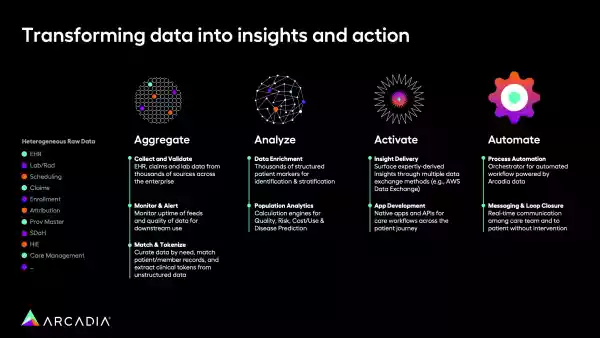The four A's to transforming data into action: A best practice guide for healthcare organizations
Healthcare data is only as useful as the actions it produces. Knowing about a population in need is helpful, but it’s ultimately meaningless if it doesn’t lead to intervention on their behalf.
Turning data into action is daunting, but the “Four A’s” framework lets healthcare organizations implement concrete steps. From aggregation (A #1) to automation (A #4), we’ll explore how this alliterative tool can simplify processes. The Four A’s strategy can make workflows more manageable for users across the spectrum, whether they’re technical, strategic, operational teams, or patients.

Read below to read about the Four A’s, and discover how they impact users across the care continuum.
1. Aggregate: Build a robust data foundation
The first step in this four-part process is aggregation, gathering up all relevant and available data so it’s prepared for use. This means building a robust data foundation through raw, heterogenous sources like EHRs, labs, scheduling data, claims, enrollment, attribution, provider notes, SDoH information, HIE, care management, and more.
If that sounds like a wide net, it is. These sources can number in the thousands, but the more that feed into a centralized platform, the more detailed picture users will get of their organization’s particular challenges and needs. The data aggregation processes follows three sub-steps:
- Collect and validate: While the depth and breadth of data sources matters, so does the data’s quality. Validation is key here to ensure that the data is usable.
- Monitor and alert: Data is never a “set it and forget it” proposition, so in this phase, it’s important to monitor data feeds continuously. This means that the data maintains quality downstream.
- Match and tokenize: Data curation is crucial. So, as users aggregate new information, it’s important to match patient and member records. This is also where organizations can extract clinical tokens from unstructured data, turning stray provider notes into data points.
2. Analyze: Cut through the noise
Once you gather data in a centralized place, it’s time to comb through it for insights. Data analysis lets healthcare organizations assess this data asset in meaningful ways and cut through the noise of so much information. Analysis happens in two important ways:
- Data enrichment: By structuring this data strategically, thousands of patient records are accessible and easy to locate. When the data is properly enriched, users can easily identify the right patients or populations and stratify them for specific initiatives. This is critical for something like a care management program, but it’s also beneficial for data analysts. Stratification and patient identification matters for initiatives, from population health to crafting individual treatment plans.
- Population analytics: A vast data lakehouse means almost unlimited options for gathering insights. With high quality data at their fingertips, healthcare leaders can measure quality and calculate risk to a fine point. They can also understand where and how costs are climbing, monitor resource usage, and predict future diseases for early intervention.
3. Activate: Put your data to work
Once healthcare organizations analyze the data, they can put it to work through a tiered-access structure, meaning different users can get access to just what they need. Highly technical teams might deal in raw data, accessing it at its most basic form, whereas providers or operational teams might get a refined, limited view of just what’s relevant (and none of what isn’t). Data can be “activated” in the following ways:
- Insight delivery: Once users have discovered insights, they need to share them — fast. Users can leverage third-party data exchange methods like the AWS Data Exchange to share information when it’s most timely, across departments.
- App development: The data’s role is to serve an organization’s goals, and to that end, organizations can activate it for use with app development. Developing native apps and APIs can enhance care workflows across the patient journey.
4. Automate: Streamline for efficiency and impact
By removing or minimizing manual processes, healthcare organizations can automate data so it’s streamlined and impactful. This leads to improved workflows and cuts out administrative tasks, and frees up care teams to get back to the work that matters most: providing exceptional service for patients, and improving outcomes in the process. In turn, operational teams can focus on driving results for the enterprise instead of troubleshooting kinks in a workflow or manually dredging up reports. Automation speeds up insights in the following ways:
- Process automation: If a group of analysts rely on a monthly report, or an intake process requires a set number of steps, automation can expedite these processes. An organization’s people spend less time clicking and searching for what they need, and more time on critical tasks.
- Messaging and loop closure: Real-time automation also benefits patients, allowing healthcare organizations to do automated, time-sensitive outreach on things like preventive vaccines or screenings. It can allow providers to communicate quickly with their patients, and help keep everyone informed and up-to-date.
Lights, camera, data A-A-A-Action
How does a CIO or population health specialist take millions of data points and turn them into something meaningful? Approaching the path from data acquisition to data action in four steps simplifies an otherwise daunting process.
- Aggregation pools all possible relevant information in a central place, and makes it usable
- Analysis cleans up the chaos and draws out insights
- Activation puts these insights in motion to serve the community, sharing discoveries across teams so that an organization’s greatest minds can get to work
- Automation helps make outreach instantaneous and comprehensive, so there’s no stone left unturned (and no time wasted on unnecessary processes)
This framework enables healthcare enterprises to compete in an ever-changing environment, and it provides four concrete stepping stones to financial and clinical success.
Learn more about how you can take these four data-oriented steps to better performance. Read below to learn more about how data transforms outcomes.
